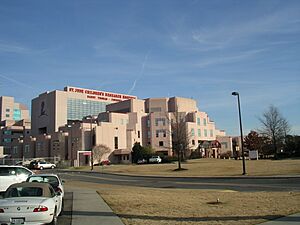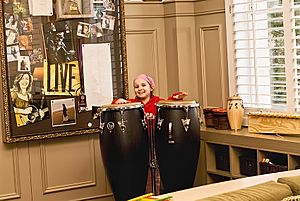St. Jude Children's Research Hospital facts for kids
Quick facts for kids St. Jude Children's Research Hospital |
|
|---|---|
 |
|

Headquarters at Danny Thomas Place, Memphis, Tennessee
|
|
| Geography | |
| Location | Memphis, Tennessee, United States |
| Coordinates | 35°09′12″N 90°02′32″W / 35.153469°N 90.042207°W |
| Organization | |
| Care system | Private & Charity |
| Hospital type | Specialized |
| Services | |
| Standards | JCAHO accreditation |
| Emergency department | No |
| History | |
| Founded | February 4, 1962 |
St. Jude Children's Research Hospital is a special hospital in Memphis, Tennessee. It helps children with serious illnesses, especially leukemia and other cancers. Famous entertainer Danny Thomas started it in 1962.
St. Jude is a nonprofit organization. This means it doesn't make money for owners. Instead, it uses donations to help kids. Patients and their families do not pay for treatment at St. Jude. The hospital covers many costs related to cancer care. St. Jude treats patients up to age 21, and sometimes up to age 25.
Contents
The Story of St. Jude Hospital
How St. Jude Began
St. Jude Children's Research Hospital opened on February 4, 1962. Danny Thomas, a well-known entertainer, founded it. He had a big dream: "no child should die in the dawn of life." This idea came from a promise he made years before.
Danny Thomas was a comedian who was just starting his career. He made a promise to Saint Jude Thaddeus. He said if he became successful, he would build a shrine to the saint. Later, Danny Thomas became very famous. He starred in a TV show called The Danny Thomas Show. He kept his promise by building St. Jude Children's Research Hospital.
Who Helps Fund St. Jude?
Most of the money for St. Jude comes from donations. The American Lebanese Syrian Associated Charities (ALSAC) helps raise these funds. ALSAC was started by Danny Thomas in 1957. They work to get donations and tell people about St. Jude's mission. Many companies and individuals give money to help.
Danny Thomas's daughter, Marlo Thomas, grew up supporting the hospital. She became its national outreach director in 1991.
Growing and Expanding
Over the years, St. Jude has grown a lot.
- In 2007, the Chili's restaurant chain promised $50 million. This money helped build the seven-story Chili's Care Center. This new building added much-needed space for clinics and labs.
- In 2010, St. Jude started the Pediatric Cancer Genome Project. This project works to find out what causes cancer in children. The goal is to find new ways to treat it.
- The Marlo Thomas Center for Global Education and Collaboration opened in 2014.
- In 2017, the St. Jude Graduate School of Biomedical Sciences welcomed its first students. These students study to become scientists and researchers.
- In 2021, the SpaceX Inspiration4 mission raised over $243 million for St. Jude. This was the first spaceflight with only private citizens.
- In 2025, YouTubers Ryan Trahan and Haley Pham raised over $11 million for St. Jude.
What St. Jude Does

St. Jude is a leading hospital for treating and researching childhood cancers. It also has an International Outreach Program. This program helps improve how many children survive serious illnesses around the world.
The hospital treats patients up to age 21. For some specific health problems, they can treat patients up to age 25.
How St. Jude is Organized
Hospital Leadership
St. Jude has had several leaders since it opened. Donald Pinkel was the first director, serving from 1962 to 1973. Other directors have included Alvin Mauer, Joseph Simone, Arthur W. Nienhuis, and William E. Evans. The current CEO and director is James R. Downing, who started in 2014.
Not a Religious Hospital
Even though it's named after a saint, St. Jude is not a Catholic hospital. It is a secular institution. This means it is not connected to any religious group.
Working with Other Hospitals
St. Jude works with many other hospitals and clinics. These are called "affiliate" sites. They are all united in St. Jude's mission to help children. As of July 2023, these sites include:
- Our Lady of the Lake Regional Medical Center, in Baton Rouge, Louisiana
- Novant Health Hemby Children's Hospital, in Charlotte, North Carolina
- Huntsville Hospital for Women & Children, in Huntsville, Alabama
- Johnson City Medical Center, in Johnson City, Tennessee
- St. Jude Midwest Affiliate, Children's Hospital of Illinois in Peoria, Illinois
- Louisiana State University, Department of Pediatrics, in Shreveport, Louisiana
- Mercy Children's Hospital, in Springfield, Missouri
- The Children's Hospital at Saint Francis, in Tulsa, Oklahoma
St. Jude also works closely with Le Bonheur Children's Medical Center in Memphis. If St. Jude patients need certain surgeries, like brain surgery, they might go to Le Bonheur. Both hospitals also help train new doctors from the University of Tennessee Health Science Center.
The Children's Cancer Center of Lebanon in Beirut is also connected to St. Jude. It opened in 2002.
How St. Jude Gets Money
St. Jude Children's Research Hospital and ALSAC are both non-profit groups. This means they rely on donations to operate. In 2012, about 81 cents of every dollar donated went directly to research and treatment. In 2020, St. Jude received about $2 billion in donations. The hospital costs about $1.7 million each day to run. About 74% of its total budget comes from donations.
Special Donations
- In 1964, Elvis Presley bought a former presidential yacht, the USS Potomac. He then gave it to St. Jude to sell. This helped raise money for the hospital.
- In 1995, St. Jude received a winning McDonald's Monopoly game piece in the mail. It was worth $1 million. Even though the rules usually didn't allow prize transfers, McDonald's made the payments to St. Jude.
Awards and Achievements
St. Jude Children's Research Hospital is known for its excellent work.
- In 2022, U.S. News & World Report named St. Jude the second-best children's cancer hospital in the U.S.
- Peter C. Doherty, Ph.D., a scientist at St. Jude, won the 1996 Nobel Prize in Physiology or Medicine. He won for his work on how the immune system fights virus-infected cells.

